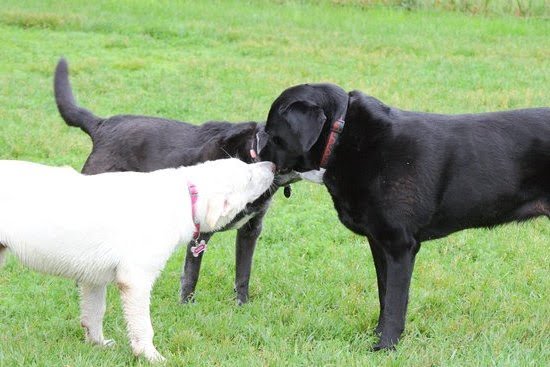Training your dog not to bite strangers is of utmost importance to ensure the safety of both your furry friend and those around them. A dog bite can have severe consequences, leading to physical injuries, emotional trauma, and even legal issues for the owner. It is crucial for dog owners to be proactive and responsible in training their pets to avoid any potential harm.
When a dog bites a stranger, it can be a terrifying experience, causing harm and instilling fear. Such behavior can stem from various triggers, including fear, territorial instincts, or lack of socialization. Understanding these triggers is essential in effectively addressing the issue and preventing future incidents.
Socialization plays a vital role in shaping a dog’s behavior towards strangers. Starting early with socialization efforts helps puppies develop confidence and positive associations with unfamiliar people. By exposing them to various environments and individuals from an early age, you can significantly reduce the likelihood of aggression or biting behaviors.
In this article, we will explore effective training techniques that build trust and confidence in dogs when encountering strangers. We will also discuss the importance of teaching basic obedience commands for better control in such situations. Additionally, we will dive into the power of positive experiences in shaping a dog’s perception of strangers and how desensitization and counterconditioning techniques can help overcome fear and aggression.
Training your dog not to bite strangers requires time, patience, and dedication. However, by committing to responsible dog ownership through proper training methods outlined in this article, you can ensure a safer environment for both your dog and the public they interact with on a daily basis.
What Causes Dogs to Bite Strangers and How to Identify the Triggers
It is essential for dog owners to understand the reasons behind a dog’s aggressive behavior towards strangers in order to effectively train and prevent biting incidents. There are several common triggers that may cause a dog to bite, including fear, territorial instincts, and lack of socialization. By identifying these triggers, dog owners can take proactive steps to address them and ensure their dog’s behavior around strangers is safe and controlled.
Fear
Fear is one of the primary reasons why dogs may resort to biting. This fear can stem from previous negative experiences or perceived threats in their environment. Dogs that have not been adequately socialized or exposed to different people and situations may develop fear towards strangers.
It is important for owners to recognize signs of fear such as trembling, growling, or cowering so they can react appropriately. If a dog displays fear-based behaviors towards strangers, it is crucial to address this issue through positive reinforcement techniques and gradual exposure.
Territorial Instincts
Dogs are naturally protective of their home and family members, which can lead to territorial aggression towards strangers. They may perceive unfamiliar individuals as intruders who pose a threat.
Signs of territorial aggression include barking excessively at the presence of strangers near the home or attempting to guard resources such as food or toys. To prevent territorial aggression, owners should establish clear boundaries and rules for their dogs while also providing positive socialization experiences with new people outside of the home environment.
Lack of Socialization
Proper socialization plays a vital role in preventing dogs from developing aggressive behavior towards strangers. Dogs that have not been exposed to various environments, animals, and people during their critical developmental period (typically between 3-14 weeks) may display skittishness or anxiety when encountering unfamiliar individuals later in life.
It is crucial for owners to engage in early socialization efforts by gradually introducing their puppies to different environments, people of all ages and appearances, and other animals. Positive reinforcement techniques should be employed during socialization experiences to promote positive associations with strangers.
By understanding the common triggers that lead to dogs biting strangers, owners can take proactive measures to prevent such aggressive behavior. Identifying fear, territorial instincts, or lack of socialization as underlying causes allows owners to tailor their training and socialization efforts accordingly. With patience, consistency, and positive reinforcement techniques, owners can effectively address these triggers and train their dogs not to bite strangers.
The Role of Socialization in Preventing Strangers Bites
Socialization plays a crucial role in preventing dogs from biting strangers. When dogs are properly socialized, they learn how to interact with different people and environments in a positive and non-threatening manner. Starting the socialization process early is key to ensuring that your dog grows up to be well-adjusted and confident around strangers.
One effective way to socialize your puppy is by exposing them to various environments and situations from a young age. Take your puppy for walks in different neighborhoods, visit parks, or even attend puppy training classes where they can meet other dogs and people. This exposure helps them become familiar with different sounds, smells, and sights that they may encounter when meeting strangers.
Another important aspect of socialization is introducing your puppy to different types of people. Gradually expose them to individuals with varying appearances, ages, and genders so that they learn to be comfortable around all kinds of people. Encourage positive interactions by rewarding your puppy when they exhibit calm behavior and follow commands when meeting new people.
Positive reinforcement techniques can be highly effective in promoting good social behavior in puppies. Reward your dog with treats, praise, or playtime whenever they display friendly behavior towards strangers. By associating positive experiences with the presence of unfamiliar individuals, your dog will start to view encounters with strangers as pleasant rather than threatening.
To further enhance the socialization process, consider enrolling your puppy in obedience classes or working with a professional trainer who specializes in this area. These experts can provide guidance on how to expose your dog to various stimuli while ensuring their safety and well-being.
Effective Training Techniques
Positive Reinforcement Methods
When training your dog not to bite strangers, it is important to use effective and humane techniques that build trust and confidence. One such method is positive reinforcement, which involves rewarding your dog for good behavior rather than punishing them for undesirable actions. This approach helps to reinforce positive behaviors and create a strong bond between you and your dog.
Using treats, praise, or toys as rewards can be highly effective in training your dog not to bite strangers. For example, when a stranger approaches and your dog remains calm and non-aggressive, immediately offer them a treat or verbal praise to let them know that their behavior is desirable. By consistently reinforcing this positive experience, their association with strangers will gradually shift towards something enjoyable rather than threatening.
Reward-Based Training
Another effective training technique is reward-based training. This method involves using rewards to motivate your dog to perform desired behaviors while ignoring or redirecting unwanted behaviors. In the context of teaching your dog not to bite strangers, reward-based training can be used to encourage alternative behaviors such as sitting or staying when a stranger approaches.
For example, when a stranger approaches and your dog starts displaying signs of aggression such as growling or lunging, calmly instruct them to sit or stay while offering treats or praise. By redirecting their attention towards the desired behavior and providing positive reinforcement, you are helping them understand that calm behavior around strangers leads to rewards.
The Importance of Consistent Training Sessions
Consistency is key when it comes to effectively training your dog not to bite strangers. Dogs learn through repetition and routine, so it is essential to set aside regular training sessions dedicated specifically to this objective.
During these sessions, practice scenarios involving the presence of strangers in controlled environments. Gradually increase the level of difficulty by simulating different situations that may trigger aggressive behavior in your dog. Ensure that each session includes a mixture of positive reinforcement, clear verbal cues, and rewards for appropriate behavior.
By consistently reinforcing the desired responses and addressing any inappropriate behaviors, you are effectively communicating to your dog what is expected of them in encounters with strangers. Remember that training requires time and patience, and it may take several sessions before you start noticing significant improvements in your dog’s behavior.
Implementing these effective training techniques will not only help build trust and confidence in your dog but also foster a positive relationship between you as their owner. With time and dedication, you can train your dog to associate strangers with positive experiences rather than an instinctive need to bite.
Teaching Basic Commands for Better Control
Teaching basic commands is a crucial aspect of training a dog not to bite strangers. These commands create a foundation for better control in situations involving unfamiliar individuals. By teaching essential obedience commands such as “sit,” “stay,” and “leave it,” dog owners can effectively manage their dog’s behavior and prevent potential biting incidents.
To teach the “sit” command, start by holding a treat close to your dog’s nose and move your hand up, allowing their head to follow the treat and causing their bottom to lower. Once they are in a sitting position, say the command “sit” and give them the treat. Repeat this process several times until your dog starts associating the command with the action.
The “stay” command helps to keep your dog from approaching strangers too swiftly or exhibiting aggressive behavior. Begin by having your dog sit in front of you. Hold out your hand towards them like a stop signal while saying the word “stay.” Take a step back, if they remain in place, praise them, and give them a reward. Gradually increase the distance as they become more comfortable with staying still.
The “leave it” command is essential for redirecting your dog’s attention away from strangers or potentially dangerous situations. Start by holding a treat tightly in your hand, then show it to your dog while saying the command “leave it.” When they stop sniffing or trying to get the treat from your hand, reward them with another treat or praise. Practice this command using various objects or toys that might capture their interest.
Consistency and practice are key when teaching these basic commands. Practice the commands regularly in different environments with increasing distractions so that your dog learns to respond reliably even when faced with strangers. Remember to use positive reinforcement techniques such as treats, praise, and rewards whenever your dog successfully follows a command.
By teaching these basic commands, you can establish better control over your dog’s interactions with strangers, reducing the risk of biting incidents. These commands also create a strong bond between you and your dog, as they learn to trust and rely on your guidance in various situations.
Positive Experiences
Encouraging positive experiences with strangers is a crucial aspect of training dogs not to bite. By creating controlled scenarios and promoting healthy interactions, owners can help change their dog’s perception of unfamiliar individuals. Here are some tips on how to encourage positive experiences and reduce the likelihood of biting behavior:
- Gradual Exposure: Start by exposing your dog to strangers in a controlled environment. Begin with individuals who are calm and familiar with dogs. Gradually increase the level of challenge by introducing new people or scenarios.
- Reward-Based Training: Use positive reinforcement techniques to reward your dog for calm and friendly behavior during interactions with strangers. Offer treats, praise, or playtime as a reward for their good behavior.
- Socialization Events: Attend socialization events or organized activities where your dog can interact with different people in a safe and controlled setting. These events expose them to a variety of stimuli and help them learn appropriate behavior towards strangers.
It is important to note that every dog is unique, and some may require more time and patience than others to feel comfortable around strangers. Owners should monitor their dog’s body language during these interactions to ensure they are not becoming overwhelmed or exhibiting signs of fear or aggression.
Furthermore, it is essential to provide regular opportunities for positive experiences throughout the dog’s life. Consistency is key in reinforcing proper behavior around strangers.
By encouraging healthy interactions and positive experiences, owners can help shape their dog’s perception of strangers and reduce the likelihood of biting incidents. Remember, this process takes time and dedication, but the ultimate goal is to have a well-socialized and friendly dog who feels comfortable around all types of people.
Desensitization and Counterconditioning: Overcoming Fear and Aggression
Some dogs may exhibit fear or aggression towards strangers due to past negative experiences or inherent anxiety. Desensitization and counterconditioning techniques can help overcome these issues by gradually exposing the dog to strangers in a controlled manner and pairing those encounters with positive experiences.
- Identify Triggers: Determine what specific stimuli or situations trigger the dog’s fear or aggression towards strangers. It could be certain types of people, certain environments, or particular behaviors.
- Set Up Controlled Scenarios: Once you have identified the triggers, create controlled scenarios where the dog can experience those triggers in a safe environment. Gradually expose the dog to these triggers at a distance that does not elicit fear or aggression.
- Pair Positive Experiences: During each exposure, immediately follow it up with something pleasurable for your dog, such as treats, playtime, or praise. This helps create positive associations with the previously triggering stimulus.
By consistently repeating this process and gradually decreasing the distance between the dog and the trigger over time, you can help your dog overcome their fear or aggression towards strangers.
It is important to remember that desensitization and counterconditioning should be approached cautiously and preferably under the guidance of a professional trainer or behaviorist. They can assess your specific situation, provide personalized advice, and ensure that the process is conducted safely for both you and your dog.
Through these techniques, dogs can learn new associations with strangers and develop more positive emotions towards them. Over time, this can help reduce their fear or aggressive response and promote healthier interactions with unfamiliar individuals.
Desensitization and Counterconditioning
Desensitization and counterconditioning are powerful techniques that can help dogs overcome their fear and aggression towards strangers. These methods involve gradually exposing the dog to strangers in a controlled and positive way, allowing them to change their emotional response.
Desensitization involves exposing the dog to strangers at a level that does not trigger fear or aggression, starting from a distance where the dog feels comfortable. Over time, the distance is gradually decreased until the dog can tolerate being in close proximity to strangers without exhibiting aggressive behavior. This process requires patience and consistency.
Counterconditioning is another technique that can be used alongside desensitization. It involves changing the dog’s emotional response to strangers by pairing their presence with something positive, such as treats or praise. By doing this repeatedly, the dog learns to associate strangers with positive experiences, which helps reduce their fear or aggression.
It’s important to remember that desensitization and counterconditioning should always be done under the guidance of a professional, especially when dealing with severe cases of fear or aggression. A professional trainer or behaviorist will have the knowledge and experience necessary to create a customized plan for your dog’s specific needs.
| Desensitization | Counterconditioning |
|---|---|
| Gradually expose the dog to strangers at a comfortable distance. | Pair the presence of strangers with positive experiences like treats or praise. |
| Decrease the distance over time until the dog can be near strangers without aggression. | Repeatedly associate strangers with positive things to change emotional response. |
Seeking Professional Help
While many dog owners are able to successfully train their dogs not to bite strangers using the techniques and tips provided, there may be instances where professional help is necessary. Recognizing when a dog’s biting behavior towards strangers requires the guidance of a dog trainer or behaviorist is crucial in ensuring the safety of both the dog and those around them.
One sign that indicates the need for professional assistance is if your efforts to train your dog have been unsuccessful. If despite consistent training sessions and effort, your dog continues to display aggressive behavior towards strangers, it may be time to consult a professional. A qualified dog trainer or behaviorist can assess your specific situation, identify any underlying issues causing the biting behavior, and provide tailored solutions and techniques to address them effectively.
Another situation where seeking professional help is advisable is if your dog’s biting behavior poses a risk to others. If your dog has already bitten someone or exhibits high levels of aggression that could potentially lead to a dangerous situation, it is imperative to consult an expert as soon as possible. A professional can help implement more advanced training methods and work with you on managing and modifying your dog’s behavior in order to prevent any future incidents.
Finding a reputable dog trainer or behaviorist requires thorough research and consideration. It is important to look for professionals who have relevant certifications, experience working with aggressive behaviors, positive reviews from previous clients, and use humane training methods. Consulting your veterinarian or local animal shelter for recommendations can also be helpful in finding qualified professionals in your area.
Remember that seeking the assistance of a professional does not indicate failure on your part as a responsible dog owner. It simply means that you are prioritizing the safety and well-being of everyone involved by recognizing when additional expertise is needed. By working collaboratively with a dog trainer or behaviorist, you can better understand the root causes of your dog’s biting tendencies and develop effective strategies for addressing them.
Conclusion
In conclusion, training your dog not to bite strangers is an essential responsibility of being a responsible dog owner. It is crucial to understand the potential negative consequences of a dog biting strangers, both in terms of harm caused and legal issues that may arise. By taking proactive and responsible action through training, we can ensure the safety of both our dogs and the general public.
Throughout this article, we have discussed various techniques and strategies to prevent dogs from biting strangers. We highlighted the importance of identifying triggers behind aggressive behavior, as well as the role of early socialization in shaping a dog’s behavior towards strangers. Additionally, we provided guidance on effective training techniques such as positive reinforcement and teaching basic commands for better control.
Encouraging healthy interactions with strangers and creating positive experiences for your dog are crucial steps in shaping their perception towards unfamiliar individuals. We also explored the techniques of desensitization and counterconditioning to help dogs overcome fear and aggression. However, it is important to acknowledge that each dog’s journey may be different, requiring patience and dedication.
Finally, should you encounter difficulties or feel overwhelmed during the training process, it is essential to seek professional help from a reputable dog trainer or behaviorist. Recognizing when expert assistance is required can make a significant difference in effectively addressing your dog’s biting behavior towards strangers.
Frequently Asked Questions
How do you stop a dog from biting strangers?
To stop a dog from biting strangers, it is essential to address the underlying causes and provide appropriate training. Firstly, it’s important to identify any triggers that may be causing the dog’s aggression towards strangers. This could include fear, territorial behavior, or past trauma.
Once the triggers are identified, a professional dog trainer or behaviorist can guide you in implementing positive reinforcement techniques and desensitization exercises to modify your dog’s behavior. Consistency, patience, and socialization are key when working with an aggressive dog. It’s crucial to create a safe environment where your dog feels comfortable and gradually expose them to controlled interactions with strangers while teaching them alternative behaviors such as sitting or staying.
Why is my dog aggressive to strangers?
There are several possible reasons why a dog may exhibit aggression towards strangers. One common cause is fear or anxiety stemming from insufficient socialization during their early development stages. If a dog wasn’t properly exposed to various people and situations during their critical socialization period (around 3-14 weeks), they may become fearful or defensive when encountering strangers later in life.
Other factors contributing to aggression can include territorial instincts, lack of confidence, protective behaviors towards their family members, pain or discomfort caused by an underlying medical condition, or prior negative experiences with strangers. Understanding the root cause of the aggression is essential for addressing the issue effectively.
Can a dog be trained out of biting?
Yes, a dog can be trained out of biting through consistent training and behavior modification techniques. However, it’s important to note that results may vary depending on the individual dog and the severity of their aggression issues. Consulting with a professional dog trainer or behaviorist experienced in aggressive cases is highly recommended as they can assess your specific situation and develop a tailored training plan accordingly.
Successful methods for training dogs out of biting often involve positive reinforcement techniques combined with systematic desensitization and counter-conditioning exercises. The focus is on teaching the dog alternative behaviors that are incompatible with biting while addressing any underlying behavioral or emotional issues. With patience, consistency, and professional guidance, many dogs can learn to overcome their biting tendencies and become well-behaved members of society.

Welcome to the blog! I am a professional dog trainer and have been working with dogs for many years. In this blog, I will be discussing various topics related to dog training, including tips, tricks, and advice. I hope you find this information helpful and informative. Thanks for reading!





